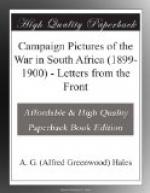Away on our right flank we can just make out the skeletons of what a few hours before had been a cluster of smiling farmhouses. They do not smile now; they grin horribly in the sunlight, grin as the fleshless skulls of dead men grin on a battlefield after those sextons of the veldt the grey-hooded, curved-beaked vultures have screamed their final farewell to the charnel-houses of war—noble war, splendid war, pastime of potentates and princes, invented in hell and patented in all the temples of sorrow.
As we look on those grim relics of this dreary time we catch the maddening sound of distant guns. The chargers prick their ears, and quiver from muzzle to coronet. The khaki-clad figures on the plain throw up their heads and turn their eyes towards the sound; the tired shoulders square themselves, each foot seems to tread the blackened plain with firmer, prouder tread. The sound of guns is like the rush of wine through sluggish veins, and men forget that they are faint with hunger, weary to the verge of wretchedness with ceaseless marching. The sound of guns bespeaks the presence of the foe, and those gaunt soldiers of the Queen are galvanised to life and lust of battle by the very breath of war. A ripple runs along the line, the farthest flanks catch the gleam of the sun on distant rifle barrels. An order rings out sharp and crisp; the column stands as if each man and horse were carved in rock.
The infantry lean lightly on their guns, the cavalry crane forward in their saddles. We pause and wait until we see the green badge of O’Driscoll’s scouts on the hats of the advancing riders. O’Driscoll rides towards the staff with loosened rein, and every spur in all his gallant little troop shows how the scouts had ridden. We strain our ears to catch the news the Irish scout has brought. It comes at last Clements has met the foe, and death is busy in those distant hills.
Rundle sits silently, hard pressed in his saddle—a gallant figure, with soldier and leader written all over him. We wait his verdict anxiously, for on his word our fate may hinge. We have not long to wait—Clements can hold his own; Brabant will outflank the Boers. Forward, march! The men droop as wheat fields droop in the sultry air of a seething day. They are tired, deadly tired; not too tired to fight, but weary of the endless marching from point to point to keep the enemy from breaking through their lines and striking southward.




